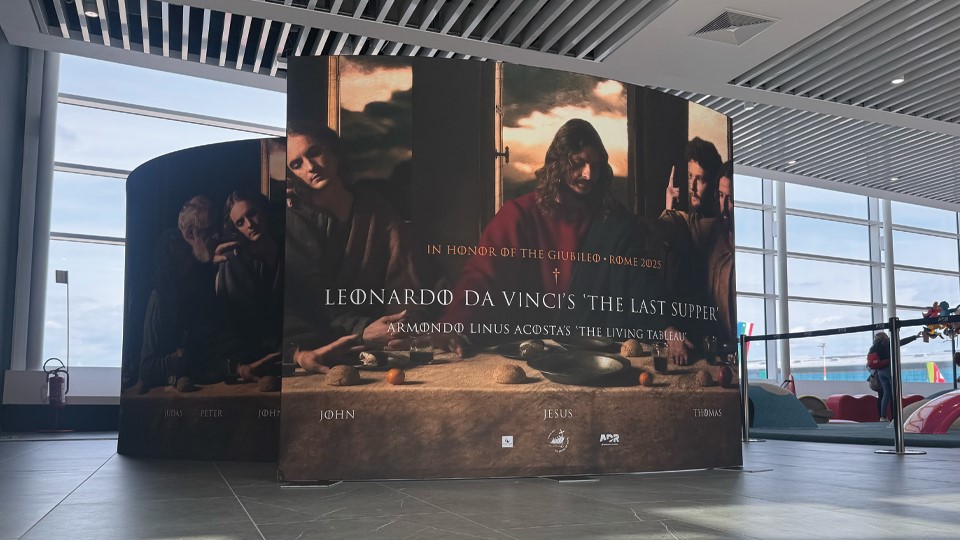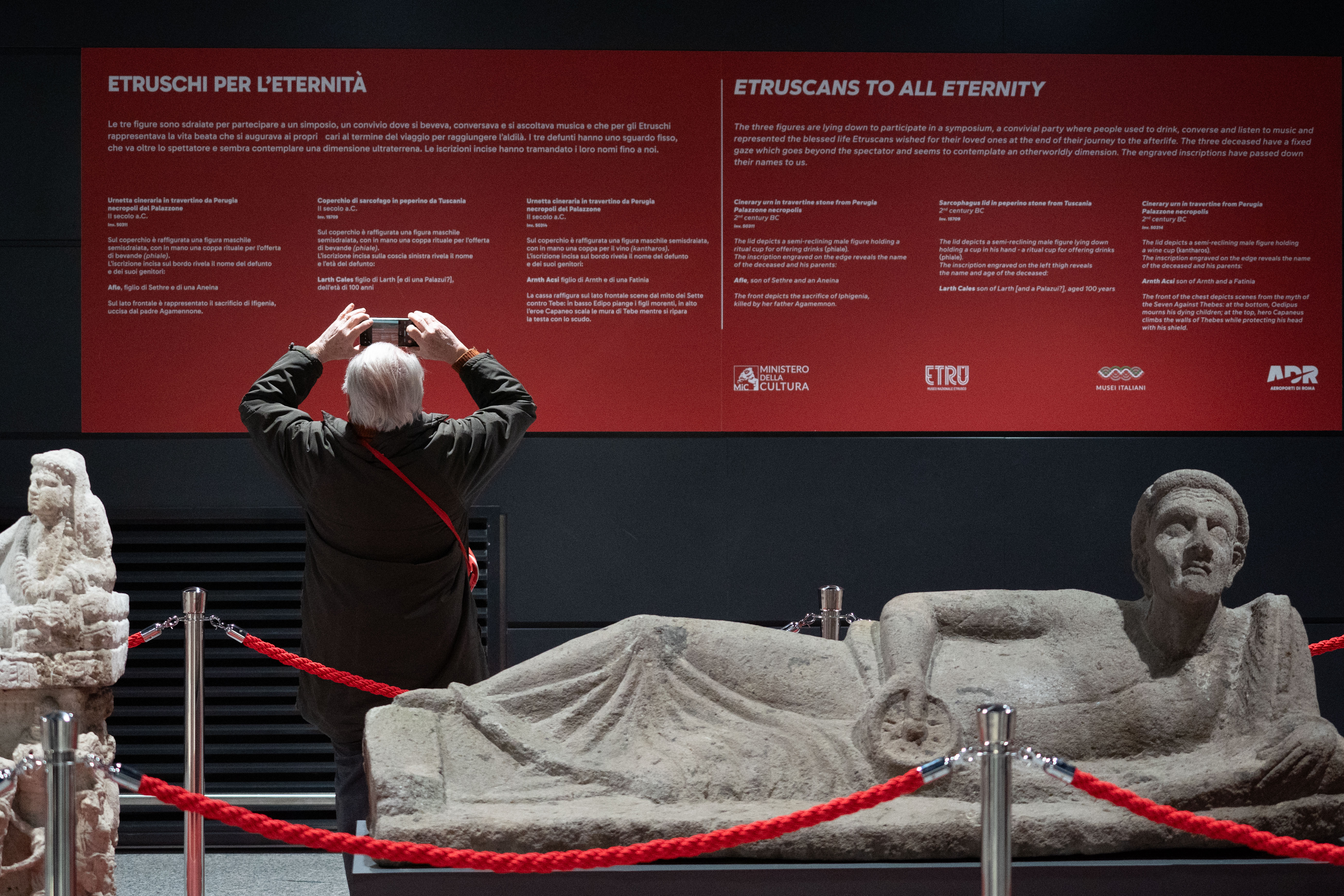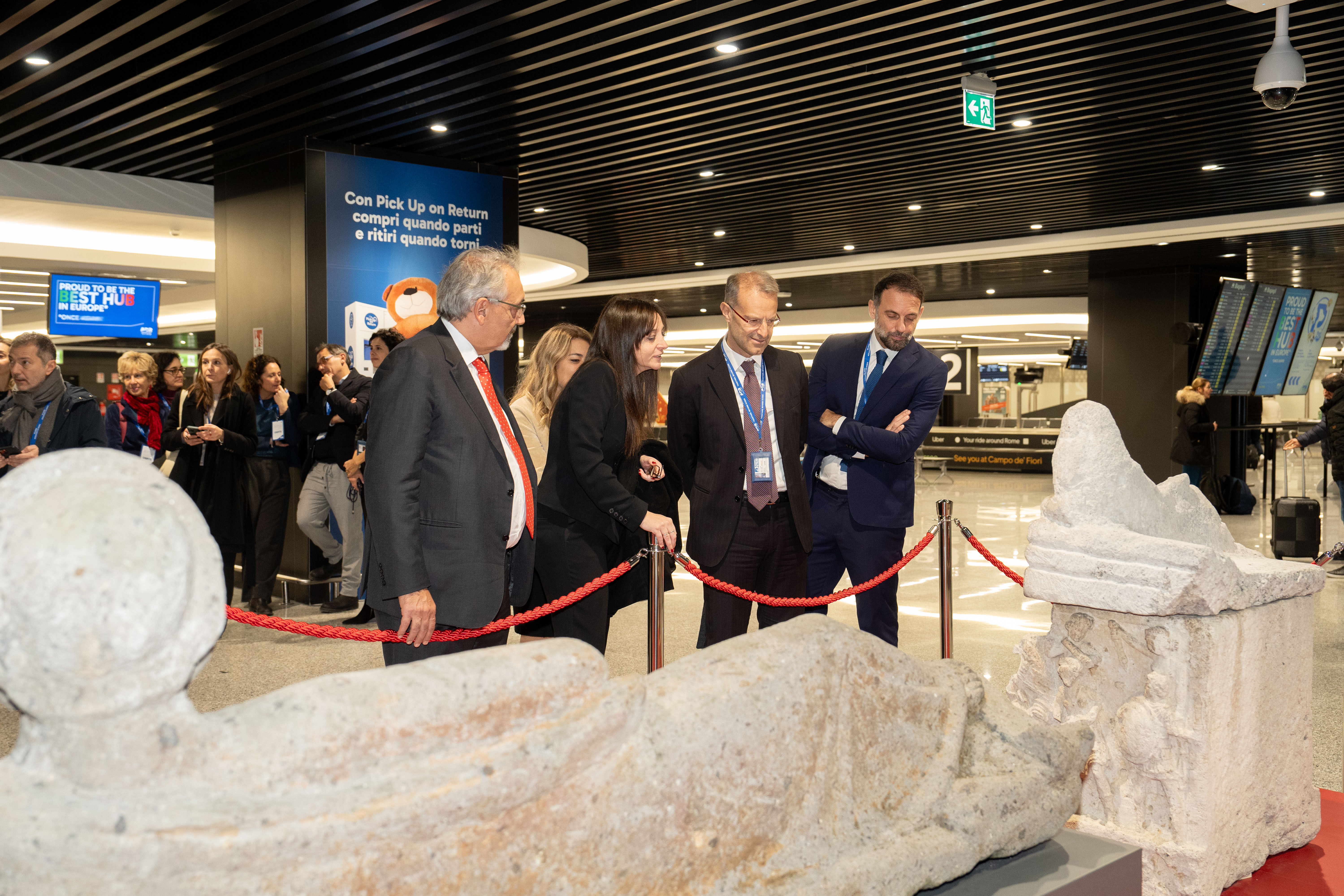Art
Art
Every day, Aeroporti di Roma strives to guarantee its passengers a unique travel experience, overturning the paradigm that sees the airport as a mere point of arrival or departure. Today, the ‘Leonardo da Vinci’ airport stands as a 'diffuse museum' within which all forms of the huge Italian cultural and artistic heritage are enhanced, acting as a stage for the promotion of talent and as a showcase for the cultural and artistic events taking place in the capital.
“Grande folla n.1” by Giò Pomodoro, one of the masterpieces of the GNAMC

From 8 May 2025, Rome's Fiumicino Airport will further enrich its dialogue with contemporary art by hosting the monumental sculpture "Grande Folla n.1" by Giò Pomodoro in Terminal 1. Pomodoro is one of the most recognised masters of 20th-century Italian sculptural abstraction.
The work, on loan from the National Gallery of Modern and Contemporary Art (GNAMC) in Rome, has been restored thanks to the support of Aeroporti di Roma and will be on display for a year, offering millions of travellers an unexpected encounter with beauty and contemplation.
Born in Orciano di Pesaro in 1930, Giò Pomodoro distinguished himself from the 1950s onwards with an artistic exploration focused on the balance between form and energy. After moving to Milan, he developed a distinctive style that combined geometric abstraction with the expressive power of materials. His body of work spans sculpture, engraving, and set design, and is present in collections and public spaces in Italy and abroad. Pomodoro has always viewed art as a living element, one that integrates into the urban landscape and the everyday life of people.
A work that comes to life among the faces in transit
Created in 1964, the sculpture stands out for its gleaming bronze, shaped into forms that evoke the flow of people in motion. Its voids and solids chase each other, creating shifting reflections in which the faces, emotions, and stories of the travellers who pass by are mirrored.
A work designed to interact with its space, to transform continuously, much like in airport terminals: places where time flows, and identities merge, even if only for a moment.
To enhance the immersive experience of passengers, Terminal 1 also features the digital installations "Pillars of Art", showcasing images of works from the collection of the National Gallery. This selection is intended to interact conceptually with Pomodoro's sculpture, offering a glimpse of the main movements and artistic currents that have shaped the history of modern and contemporary Italian art.
A symbol of Italy looking to the future
"Grande Folla n.1" is not only a testament to the expressive power of Giò Pomodoro but also serves as an emblem of an Italian art in constant motion, capable of evolving, experimenting, and engaging with the present.
Its presence in the heart of Terminal 1 represents a strong, immersive, and contemporary artistic gesture, designed to welcome travellers with an invitation to discover a vibrant Italy, one that is rooted in history but continues to generate innovation and creativity.
This message also reflects the identity of the National Gallery of Modern and Contemporary Art, the custodian of an extraordinary heritage in terms of both scale and variety: over 20,000 works, including paintings, sculptures, installations, photographs, design objects, and videos, the result of more than a century of acquisitions and donations from artists and patrons.
The Last Supper: “The Living Tableau” by Armondo Linus Acosta

On the occasion of the Jubilee Year, Leonardo da Vinci Fiumicino Airport presents The Last Supper: The Living Tableau, a video installation inspired by Leonardo da Vinci's masterpiece, “The Last Supper”.
Directed by American award-winning filmmaker Armondo Linus Acosta, this nine-minute cinematic work was created through the collaboration of three renowned names in Italian cinema, all Oscar winners: cinematographer Vittorio Storaro, set designer Dante Ferretti, and set decorator Francesca Lo Schiavo.
First presented in 2019 to mark the 500th anniversary of Leonardo’s death, the installation has already been showcased in numerous international cultural venues. Displayed within Terminal 1 of Fiumicino airport, this exhibition is part of a broader initiative aimed at bringing art into spaces of transit and connection, making it accessible to a wide and diverse audience.
The narrative begins with a timeless landscape, accompanied by Rossini’s Stabat Mater. Gradually, the scene unfolds: the room, the table, the twelve apostles, and finally, Jesus, who performs the gesture of blessing and announces the betrayal. The staging is meticulously crafted, with perspective, lighting, costumes, and movements all designed to capture the visual and symbolic essence of the original painting.
A distinctive element of the project is the casting choice: instead of professional actors, members of the production team were selected for their resemblance to the characters in the painting. The director himself portrays the apostle Thaddeus. The costumes, tailor-made from plaster molds, enabled the creation of static poses faithful to Leonardo’s iconic depiction.
The result is a powerful work that, despite its stillness, conveys profound emotions through glances, lighting, and silence.
This initiative offers a unique cultural experience within the airport, a space frequented every day by thousands of people. In a context defined by travels, waiting and movements, The Living Tableau offers a moment of pause and reflection, accessible free of charge to passengers and visitors.
Etruscans for Eternity

On Monday, December 16, 2024, Fiumicino Airport unveiled an exhibition featuring three remarkable Etruscan sculptures from the permanent collection of the National Etruscan Museum of Villa Giulia.
The exhibition, titled "Etruscans for Eternity," was unveiled in the Terminal 1 arrivals hall, offering thousands of daily passengers the opportunity to admire these extraordinary masterpieces. The inauguration was graced by the presence of Marco Troncone, CEO of Aeroporti di Roma; Luana Toniolo, Director of the National Etruscan Museum of Villa Giulia; Francesco Rocca, President of the Lazio Region; and Roberto Vannata, from MIC’s General Directorate for Museums.
Through a collaboration between Aeroporti di Roma, the Directorate-General for Museums and the National Etruscan Museum of Villa Giulia, these remarkable artefacts of Etruscan culture have been "brought to life" at the airport. Carefully chosen by the museum's curators, the sculptures offer visitors a captivating window into the rich heritage of this ancient civilisation, encouraging them to explore the museum further.
The exhibition showcases two travertine funerary urns from Perugia and a sarcophagus lid from Tuscania. These exquisite pieces portray idealised figures of Laris Afle, Arnth Acsi, and Larth Cales—believed to be aristocratic men from the 2nd century B.C. Each is depicted reclining at a symposium, a cornerstone of Etruscan social life, where attendees gathered to drink, chat and enjoy music.
The bases of the urns are intricately decorated with mythological scenes, including The Seven Against Thebes, where Oedipus mourns his sons, and the Sacrifice of Iphigenia by her father Agamemnon. These timeless Greek myths, rich with universal themes that continue to resonate, embody the core values of Etruscan society. Through their exploration of real and symbolic journeys, the sculptures encourage contemplation of the past and future, reality and imagination, as well as lived experiences and aspirations.
This collaboration received strong backing from Luana Toniolo, Director of the National Etruscan Museum of Villa Giulia, who remarked: "Our aim is to extend the museum’s reach beyond its walls, bringing it into high-traffic spaces like airports to create 'oases' of beauty that spark reflection on the shared cultural heritage we all possess. Through this partnership with Aeroporti di Roma, we aim to expand awareness and foster greater appreciation for our cultural treasures, even among travellers in transit."
Aeroporti di Roma has consistently embraced a strategy of promoting and celebrating Italy's rich cultural heritage through partnerships with renowned cultural institutions and museums. These collaborations have brought archaeological treasures, artworks spanning diverse eras, and contemporary installations to Leonardo da Vinci Airport. The initiative seeks to redefine transit spaces as vibrant showcases for art and culture in all their forms.
"With the unveiling of these three remarkable sculptures, we are enhancing the artistic and cultural offerings at our airport, marking the beginning of a strategic partnership with the National Etruscan Museum of Villa Giulia," said Marco Troncone, CEO of Aeroporti di Roma. "Today, we offer our passengers and the entire airport community the opportunity to engage with the historical legacy of the Etruscan civilisation's historical significance, which also flourished in the region surrounding our airport. ADR's dynamic artistic and cultural programming has long been a key element of our sustainable development strategy, playing a pivotal role in transforming Fiumicino Airport into a stunning showcase of Italy’s beauty and cultural heritage."
"The airport is a powerful symbol of modernity and often the first point of contact for travellers arriving in the region. It is a remarkable opportunity that this contemporary space engages with antiquity and serves as a ‘showcase’ for our cultural heritage. The display of invaluable artefacts from the Etruscan Museum of Villa Giulia at Leonardo da Vinci Airport, now a true ‘open-air museum,’ perfectly aligns with the vision I have advocated since the beginning of my term to promote the Lazio region," added Francesco Rocca, President of the Lazio Region.

Stream of Light: from 13 December 2024
From today, passengers at Rome Fiumicino Airport can experience the striking sculpture Stream of Light by artist Helidon Xhixha, displayed outside the Terminal 1 departures hall as a tribute to the city of Rome. This monumental piece measures 4.8 metres in length, 4.2 metres in depth and 10.7 metres in height, crafted from marine steel with a corten steel base, a high-resistance alloy renowned for its durability.
The choice to showcase Stream of Light at Leonardo Da Vinci Airport is no accident. The sculpture embodies energy and movement, and its iconic triangular form symbolises travel and the connection between cultures. The grooves along its central structure transform the piece into a representation of light, cutting dynamically through matter with force and purpose. The steel symbolises both strength and stability, offering a sense of reassurance. Its design represents the flow of energy and connection, conveying a vision of the future filled with hope and endless possibilities.

Master of Mistakes: from 9 April 2024
If we were to collect all the mistakes we have made or even only considered, they would fill more than a large room. And mistakes are heavy, sometimes like boulders, and turn into a sense guilt, regret and remorse. Piling them all up together, they can reach half a tonne in weight, then they roll over and crush you, even if they do not fall on top of you. These were the reflections of Daniele Sigalot when he created 'Master of Mistakes'. This work is an opportunity for self-analysis that is also directed towards others, towards the spectator, as is the case with other works by the artist who specialises in exploiting the ambiguity of materials. A shape that seems light becomes heavier by accumulation; this is not a pipe and it is not even a sheet of paper, but it’s a piece of aluminium, and one on top of another, they become a giant figure, nothing valiant or heroic, but a monument dedicated to that which we would like to forget about ourselves.
‘Master of Mistakes’ is a visual panacea and touches our very essence, which is what we look for in a work of art: to satisfy us aesthetically and provoke deep reflection. Daniele Sigalot's work has been installed at Fiumicino Airport since 9 April; he particularly likes the airport space because he the audience—who will see his work and how—is unknown. Outside the protections of the context, the sculpture is intended for the inscrutable yet biographical spectator: each viewer will see in it what they want to find.

Aaron Two Saints Deacon Martyrs (c. 1305-1310)
During the event celebrating ADR's 50th anniversary, three prestigious stained-glass windows were unveiled whose design, following strict stylistic comparisons by medievalist scholars, was attributed to Giotto, the master of painting: the great artist renewed the language of medieval art by overcoming the stylised Byzantine lexicon and developed a new style that would extend as far as the Renaissance with famous fresco cycles such as the Stories of St. Francis in the Basilica of St. Francis in Assisi. The three panels depict the prophet Aaron, priest par excellence of the Old Testament, in the tondo, whereas the ogival ones show two deacons with tonsured heads, wearing dalmatic and carrying the palm of martyrdom.
Taken together, the three panels comprehensively meet the need to showcase the richness and complexity of Italy's artistic heritage to the large public passing through Rome Fiumicino airport and thus having the chance to enjoy these works of art.
The three illustrated stained-glass windows attributed to Giotto, accompanied by 'experiential' columns on which some of the high-definition photographic images of works by the great master are projected, thanks to their new location in the frame of Pier A, can be admired during the exhibition period (from 12 February until September 2024) by millions of passengers departing and arriving for national, European and intercontinental destinations.

"Vertigine" by Manuel Felisi: from 21 November 2023

Natural Reaction by Marcantonio: from 12 September 2023

Salvator Mundi by Gian Lorenzo Bernini: from 12 April to 31 August 2023
From 12 April to 31 August, Terminal 1 Boarding Area A hosted Bernini's 'Salvator Mundi', a sculpture owned by the Italian Interior Ministry’s Fondo Edifici di Culto (Worship Buildings Fund). This gave the more than 6 million passengers passing through the area the unique opportunity to admire this timeless artwork, including in guided tours open to everyone. Salvator Mundi is Giovan Lorenzo Bernini's last masterpiece and is usually exhibited in the Basilica of San Sebastiano fuori le mura. It depicts the Blessing Christ in half-length: Christ's face, adorned with long hair, turns to the right with an expression of great serenity and majesty, and his right hand in the act of blessing is on the left side of his chest.

Deti: from 18 May 2022
More contemporary forms of art are also explored at Fiumicino airport, such as Marco Lodola's 'Deti' (from the Cyrillic word for 'Children'), which, positioned at Pier A, is a tribute to Picasso's famous dove and, with its colours reminiscent of the flag of peace, is intended as a reminder.

Men and Gods in Ancient Ostia: from 18 May 2022
Images of time: from May 2017 to November 2023





